Research
Graphene-based wireless sensors:
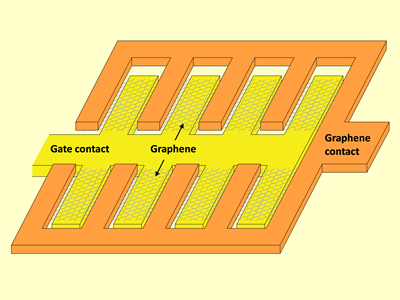
In this project, we are developing a revolutionary type of wireless sensor that utilizes the quantum capacitance in graphene as its operational mechanism. By fabricating a metal-oxide-graphene capacitor (as shown on the right) a variable capacitor (or varactor) can be realized, which when integrated with an inductor, can form a tunable resonant circuit that can be interrogated wirelessly. We are currently investigating this concept it to realize wireless glucose sensors for use in closed-loop glucose control systems (sometimes called the "artificial endocrine pancreas"). We are also investigating it for a wide-variety of other sensing applications, including vapor-phase sensors for point-of-care disease diagnosis. This work is being performed in collaboration with Drs. Yogish Kudva and Ananda Basu at the Mayo Clinic, and Advanced Medical Electronics (AME) and is sponsored by the Minnesota Partnership for Biotechnology and Medical Genomics and the National Institutes of Health (NIH). A recent presentation describing the graphene varactor sensor technology is provided here.
Radiation dosimeters for cancer therapy:
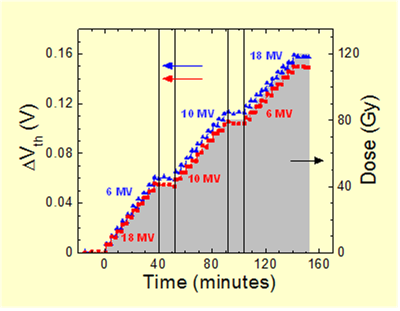
Sensors based upon fully-depleted silicon-on-insulator (FDSOI) layers are being studied for use as wireless dosimeters in radiation cancer therapy. In this project, we utilize the inherent charge trapping properties of silicon dioxide to create variable capacitors sensitive to therapeutic X-rays used in external-beam therapy. Similar to the graphene varactors, these devices can be used to create an ultrasmall passive sensor that can be placed near the treatment site and interrogated wirelessly, providing during real-time dosimetry before, during and after treatment. We are performing experiments using both linear accelerators and Co-60 gamma radiation sources. Extremely reproducible and reliable measurements have achieved using these devices as shown on the right. This work is being performed in collaboration with Drs. Bruce Gerbi and Margaret Reynolds in the Department of Therapeutic Radiology at the University of Minnesota and is sponsored by the NIH. The fabrication procedure for our high-speed FDSOI varactors is provided here.
Two-dimensional (2D) semiconductors:
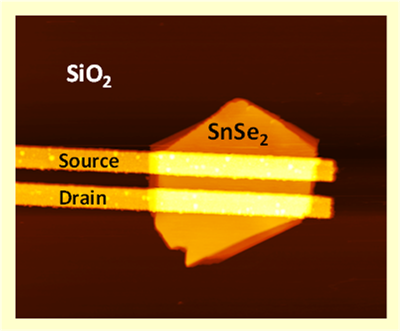
The Koester NanoDevice Laboratory has several projects related to two-dimensional (2D) semiconducotors:
We are exploring how 2D materials can create a novel type of logic device called a tunneling field-effect transistor (TFET). TFETs utilize band-to-band tunneling to create a device that have steeep subthreshold slope and therefore operate at lower power than conventional MOSFETs. One heterostructure combination that could allow the realization of high-performance 2D TFETs is the MoTe2/SnSe2 material system due to its predicted broken-gap band alignment. The figures at right show our progress on realizing the individual components of these devices where we have demonstrated operational SnSe2 and MoTe2 MOSFETs. This work is being performed in collaboration with Dr. Mathieu Luisier at ETH, Zurich and is sponsored by the NSF through the MRSEC program.
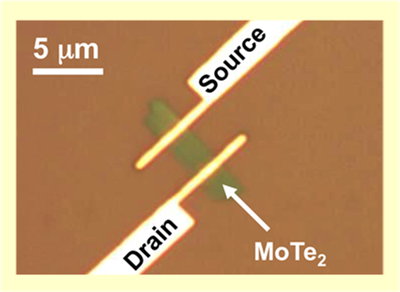
We are also exploring how ionizing radiation affects the properties of devices fabricated using 2D crystals such as molybdenum disulphide (MoS2) and other layered semiconductors. This research is being performed in collaboration with Dr. Chris Kim in the ECE department at the University of Minnesota and Dr. Michael Alles and several researchers at Vanderbilt University. This work is sponsored by the Defense Threat Reduction Agency (DTRA).
Finally, the Koester NanoDevice Laboratory is exploring how optoelectronic devices can be realized using 2D materials. Graphene and We have projects to explore graphene-based optical modulators as well as photodetectors using graphene and other 2D semiconductors. This research is being performed in collaboration with Dr. Mo Li in the ECE department at the University of Minnesota, Dr. Xiaodong Xu at the the University of Washington and several other researchers. This work is sponsored by the Air Force Office of Scientific Research (AFOSR).
All-spin logic devices:
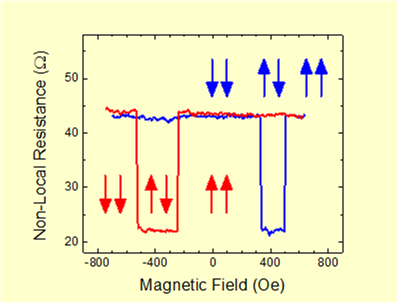
We are investigating materials and devices that will allow computation using electron's spin as opposed to its charge. These novel "spintronic" devices could allow much low energy consumption for computational systems and also enable novel computational paradigms such as neuromorphic computing. In particular, the Koester group has investigated the use of graphene as a channel material in spin logic systems. The data at right shows results from our CVD graphene spin valves, which are used to measure spin currents in graphene and are useful for optimizing the spin device performance. The Koester group is performing this work as part of the Center for Spintronic Materials, The Center for Spintronic Materials, Interfaces and Novel Architectures (C-SPIN) which is homed in the ECE Department at the University of Minnesota. C-SPIN is a member of STARnet, a joint program supported by the Semiconductor Research Corporation (SRC) and the Defense Advanced Research Projects Agency (DARPA). Additional aspects of this work are supported by the National Science Foundation (NSF) and the SRC.
Funding:
Agency: Boston Scientific Corporation, Title: “Biosensors,” Investigators: Arthur Erdman (PI), Steven J. Koester and others(co-PIs), Amount: $336,363 [26%], Duration: 2015-2016.
Agency: National Science Foundation, Program: Division of Materials Research (DMR), Title: “Materials Research Science and Engineering Center (MRSEC),” Investigators: Timothy Lodge (PI), and others, Amount: $17,800,000 [4%], Duration: 2014-2020.
Agency: Minnesota Partnership for Biotechnology and Medical Genomics, Program: Decade of Discovery in Diabetes Title: “A Revolutionary Multiple-Input Sensor Platform for Realizing the Artificial Pancreas,” Investigators: Steven J. Koester (co-PI), Yogish Kudva (co-PI), Ananda Basu (co-I), Amount: $500,000 [80%], Duration: 2013-2015.
Gift: Honeywell Corporation, Title: “Black phosphorus research fund,” Investigators: Steven J. Koester, Mo Li, Stephen A. Campbell, Amount: $50,000 [48%].
Agency: Boston Scientific Corporation, Title: “Biosensors,” Investigators: Arthur Erdman (PI), Steven J. Koester and others (co-PIs), Amount: $336,363 [26%], Duration: 2015-2016.
Agency: University of Minnesota, Program: Institute of Engineering in Medicine (IEM) Seed Grant Title: “Biomedical Sensor Technology Working Group,” Investigators: Steven J. Koester (PI), Amount: $6,000 [100%], Duration: 2015.
Agency: University of Minnesota, Program: Institute of Engineering in Medicine (IEM) Seed Grant Title: “Radiation Dosimeters for Cancer Therapy with Enhanced Sensitivity and Reliability Using Two-Dimensional Materials,” Investigators: Steven J. Koester (co-PI), Bruce J. Gerbi (co-PI), Amount: $25,000 [50%], Duration: 2015.
Agency: National Science Foundation, Program: Division of Materials Research (DMR), Title: “Materials Research Science and Engineering Center (MRSEC),” Investigators: Timothy Lodge (PI), and others, Amount: $17,800,000 [4%], Duration: 2014-2020.
Agency: Air Force Office of Scientific Research, Program: Basic Research Initiative: 2D Materials and Devices Beyond Graphene Title: “2D Heterostructures for Integrated Nano-Optoelectronics,” Investigators: Xiaodong Xu (PI), Steven J. Koester (co-PI), Mo Li (co-PI), Fengnian Xia (co-PI), Di Xiao (co-PI), David Cobden (co-PI), David Cohen (co-PI), Robert Moore (co-PI), Zhi-Xun Shen (co-PI), Amount: $ 3,000,000 [14%], Duration: 2014-2017.
Agency: Defense Threat Reduction Agency, Program: Basic Research for Combating Weapons of Mass Destruction (C-WMD) Title: “Radiation Effects in Two-Dimensional Material / High-K Dielectric Interfaces,” Investigators: Steven J. Koester (PI), Chris H. Kim (co-PI), Michael Alles (co-PI), Ronald Schrimpf (co-PI), Daniel Fleetwood (co-PI), Robert Reed (co-PI), Enxia Zhang (co-PI), Amount: $ 1,050,000 [37%], Duration: 2014-2016.
Agency: National Institutes of Health, Program: National Institute of Diabetes and Digestive and Kidney Disease (NIDDK) Title: “Glucose Monitor with Graphene-Based Disposable Wireless Sensors,” Investigators: Gary Havey (PI) and Steven J. Koester (co-PI), Amount: $ 69,402 [100%] – University of Minnesota subcontract funding, Duration: 2013-2014.
Agency: National Institutes of Health, Program: National Cancer Institute (NCI) Title: “Ultrasmall Wireless Dosimeters for in vivo Radiation Dosimetry,” Investigators: Steven J. Koester (PI), Bruce J. Gerbi (co-PI), Margaret Reynolds (co-I), Amount: $330,038 [61%], Duration: 2013-2015.
Agency: Minnesota Partnership for Biotechnology and Medical Genomics, Program: Decade of Discovery in Diabetes Title: “A Revolutionary Multiple-Input Sensor Platform for Realizing the Artificial Pancreas,” Investigators: Steven J. Koester (co-PI), Yogish Kudva (co-PI), Ananda Basu (co-I), Amount: $500,000 [80%], Duration: 2013-2015.
Agency: SRC/DARPA, Program: STARnet, Title: “Center for Spintronic Materials, Interfaces and Novel Architectures (C-SPIN),” Investigators: Jianping Wang (director), Steven J. Koester (co-director), P. M. Crowell (co-director), 28 other co-PIs, Amount: $29,654,508 [3.5%], Duration: 2013-2017.
Agency: Minnesota Partnership for Biotechnology and Medical Genomics, Program: Decade of Discovery in Diabetes Title: “Graphene-Based Wireless Glucose Sensing for the Artificial Pancreas,” Investigators: Steven J. Koester (co-PI), Yogish Kudva (co-PI), Ananda Basu (co-I), Amount: $500,000 [71%], Duration: 2012-2013.
Agency: National Science Foundation, Program: Grant Opportunities for Academic Liaison with Industry (GOALI), Title: “GOALI: Nanowire broken-gap tunneling field-effect transistors for high-performance, ultra-low-power logic applications,” Investigators: Steven J. Koester (PI) and Wilfried E. Haensch (co-PI, IBM), Amount: $330,000 [100%] Duration: 2011-2014.
Agency: University of Minnesota, Program: Institute of Engineering in Medicine Seed Grant (IEM) Title: “Novel radiation-sensitive varactors to enable ultrasmall wireless dosimeters for radiation cancer therapy,” Investigators: Steven J. Koester (co-PI), Bruce J. Gerbi (co-PI) Amount: $39,796 [53%], Duration: 2011.
Agency: University of Minnesota, Program: Grant-in-Aid Title: “Nanowire devices fabricated using block copolymer lithography,” Investigator: Steven J. Koester (PI), Amount: $33,516 [100%] Duration: 2010-2012.
Agency: National Science Foundation, Program: ECCS / EPMD Title: “Scalable perpendicular all-spin non-volatile logic devices and circuits with hybrid interconnection,” Investigators: Jianping Wang (PI), Steven J. Koester (co-PI), Paul M. Crowell (co-PI), Chris Kim (co-PI), Amount: $1,300,000 [25%] Duration: 2011-2015.
Agency: Semiconductor Research Corporation, Program: Nanoelectronics Research Initiative, Title: “Scalable perpendicular all-spin non-volatile logic devices and circuits with hybrid interconnection,” Investigators: Jianping Wang (PI), Steven J. Koester (co-PI), Paul M. Crowell (co-PI), Chris Kim (co-PI), Amount: $200,000 [25%], Duration: 2011-2015.
Agency: National Science Foundation, Program: Division of Materials Research (DMR), Title: Materials Research Science and Engineering Center (MRSEC) Seed Project – “Ultrasmooth graphene nanoribbon formation using templated nanoparticle crystallographic etching,” Investigators: Steven J. Koester (PI) of seed program Amount: $100,000 [100%], Duration: 2010-2012.
Gift: Alice M. O’Brien Foundation, Title: “Artificial pancreas research fund,” Investigator: Steven J. Koester, Amount: $47,500.
